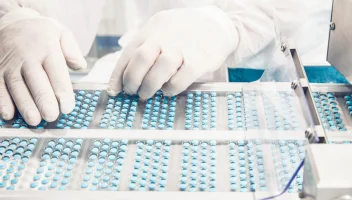Copyright for Engineered DNA, Part 2
Copyright for Engineered DNA, Part 2
Copyright for Engineered DNA, Part 2
19 Jul 2017
Aptean Staff Writer
With the United States Supreme Court ruling in Myriad, the enforceability of certain claims in existing gene patents and the broader patentability of genetic material has been cast into a state of some disarray.
In this three part series, guest blogger and thought leader Professor Chris Holman at the University of Missouri-Kansas City Law School explores the idea that copyright law rather than patent law may better suit genetic material as intellectual property. Professor Holman authors the well-known Holman’s Biotech IP Blog and is the executive editor of Biotechnology Law Report.
Please see Part 1 should you have missed it.
… Given the similarity of computer code and genetic code, why has copyright been extended to one but not the other?
In part, I think the answer lies in the fact that in the 1970s, as the development of computer software was first coming to be recognized as an economically significant enterprise, it was far from clear whether patent protection would be available for computer programs. Indeed, two Supreme Court cases decided in 1972 and 1978, Gottschalk v. Benson and Parker v. Flook, held that the computer programs at issue in those cases were not patent eligible. Given the substantial investment required to develop commercially relevant computer programs, and the ease with which the resulting product could be copied and illicitly disseminated, some form of intellectual property was deemed necessary.
Patents are the form of IP traditionally associated with technology, but if patents were not going to be available for computer programs, then perhaps copyright could be enlisted. A number of copyright experts, particularly legal scholars, argued vehemently at the time that copyright should not be extended to software, but ultimately the Copyright Office began registering computer programs under a “rule of doubt” in the 1960s, and in the 1970s and early 80s the courts issued a number of decisions upholding the copyrightability of computer code, even highly utilitarian software written in a form that can only be read by computers. In 1981 the Supreme Court decided Diamond v. Diehr, upholding the patentability of the computer program at issue in that case, and in the 1980s and 1990s relatively expansive patent protection became available for computer programs, which led to the current coexistence of patent and copyright protection for software.
In contrast, since the earliest days of biotechnology patents have been viewed as an effective means of protecting biotechnological innovation, a belief fostered by the Supreme Court’s 1980 decision in Diamond v. Chakrabarty which held that genetically modified living organisms can be patented, and generally espousing an expansive view of the scope of patentable subject matter. With the availability of patents, there was no compelling need to push for an alternative form of protection such as copyright. Furthermore, the earliest products of biotechnology tended to involve relatively simple genetic constructs comprising only slightly modified versions of naturally-derived sequences, thus looking less like an engineered sets of instructions than does computer code.
I can imagine at least two types of bioengineered sequences with respect to which copyright might be applicable. One would be synthetic protein-coding sequences, i.e. synthetic genes. Each codon of such a sequence represents an instruction directed towards a biological machine – start or stop translation, or incorporate a specified amino acid into a growing peptide chain. As an ordered set of instructions directed towards a machine, it should be copyrightable for the same reasons a computer program is, assuming it meets the various requirements for copyrightability such as originality, creativity and fixation, as discussed below and in greater detail in my DNA copyright law review article.
The second category of potentially copyrightable genetic works would include constructs made by combining multiple genetic coding elements, as exemplified by the Smolke lab’s engineered opioid synthesis construct. Professor Endy has written extensively on the increasingly modular structure of the products of synthetic biology, which he points out is analogous to the modular nature of computer programs, as well as other more traditional works of engineering. Even a construct comprising nothing more than a unique reconfiguration of naturally occurring genetic elements could be afforded copyright protection, at least if that configuration exceeds some threshold level of originality and creativity. It is well-established that an original “selection, arrangement, or coordination” of uncopyrightable elements can result in a copyrighted work.
In the context of software, copyright is particularly effective as a tool for going after pirates, i.e., those who takes advantage of the ease with which computer code can be copied and seek to profit from the commercialization of unauthorized copies. In the same way, I think that copyright could play an important role in policing against the pirating of bioengineered products. Genetically modified seeds are one type of product that I can imagine really benefiting from copyright protection.
Like software, genetically modified seeds are highly vulnerable to piracy, given the ease with which the product can be used as the template for the production of a virtually unlimited number of unauthorized copies. Patent owners like Monsanto currently rely heavily on patents to go after farmers who illicitly save patented seeds to plant the next season, or to sell to others. There could be a number of practical advantages to the use of copyright in conjunction with, or as an alternative to, patents, much as is the case today with respect to software. The enforcement of copyright can be more straightforward – proving copying in the case of piracy, for example, should be easier in many cases than proving patent infringement, and dealing with a defendant’s claims of invalidity or unenforceability would be less of a burden for a copyright plaintiff than is the case with patents. The remedies available for a prevailing copyright owner can also be attractive, and there is even the possibility of pursuing criminal enforcement of copyright in particularly egregious instances of piracy, or of blocking importation.
In fact, there are a number of advantages of copyright over patent that could be of benefit to biotechnology innovators. Obtaining patent protection is notoriously expensive and time-consuming, and often takes years after the initial filing of the patent application. Copyright, in contrast, exists from the moment a copyrightable work is “fixed in a tangible medium of expression.” In other words, a copyrightable DNA sequence would be protected by copyright from the moment it is first embodied in a DNA molecule, or recorded as a string of letters on a piece of paper or on a computer-readable medium like a hard drive. Unlike a patent, there is no need to seek government approval for a copyright. It is possible to register a copyrighted work with the Copyright Office, and there are a number of advantages to doing so, but the copyright exists at the time of fixation regardless of whether the work is registered or not. Thus copyright could be an attractive alternative for a company that is generating a large number of synthetic DNA sequences for which patent protection would be prohibitively expensive. The availability of protection from the time of fixation would also be an advantage with respect to a company seeking to quickly commercialize a product based on engineered DNA, perhaps months or even years before a patent would issue.
In many ways copyright protection would be substantially thinner and less robust than patent protection, and indeed that is one of its main advantages, since it could provide some meaningful protection without unduly hindering subsequent research and innovation by others. There are those that complain that biotechnology patents, especially so-called “gene patents,” threaten to create a thicket of property rights that impede basic research and follow-on innovation, and this seems to have been a concern that the Supreme Court sought to address in Myriad. In fact, there are many critics of software patents who argue that the more limited rights of copyright are a preferable form of intellectual property for computer programs, and for much the same reasons the same could be the case for some, although by no means all, engineered DNA products.
For one thing, copyright infringement only occurs if one actually copies a copyrighted work. Independent creation is an absolute defense, which is not the case with patents.
It is also significant that copyright would not cover the functionality of engineered DNA, only the specific copyrighted DNA sequence, and perhaps some relatively similar sequences. This is a direct consequence of one of the most foundational principles of copyright, which lawyers refer to as the “idea-expression dichotomy,” –i.e., copyright does not extend to ideas, but instead is limited to a specific means of expressing the idea. As applied to engineered DNA, the idea-expression dichotomy essentially prevents copyright from tying up the functionality (the “idea”) of an engineered DNA sequence, but can only be used to preclude others from copying the specific sequence used by the copyright owner to achieve that functionality (the “expression”), and probably some relatively narrow set of highly similar sequences. Thus, any third-party would be free to copy the functionality of an engineered DNA sequence, so long as that third-party is willing to invest the effort in coming up with an alternative DNA sequence for achieving that function. In the case of a synthetic gene, for example, the redundancy of the genetic code should allow for a virtually unlimited number of non-infringing alternatives. Importantly, the relative thinness of copyright does not diminish its utility as a means for going after pirates, as illustrated by the success with which suffer companies have been able to wield their copyright.
There are a number of limitations on the scope of copyright protection afforded software that flow directly from the idea-expression dichotomy, and which by analogy would be applicable to engineered DNA. For example, under what is referred to as the “merger” doctrine, if there are only a limited number of ways to achieve a particular function, those expressions cannot be copyrighted, out of concern that any copyright might threaten to impermissibly restrict access to the functionality. Furthermore, elements of a computer program that are derived from the public domain, or dictated by considerations of efficiency, or dictated by external factors (such as requirements for interoperability with hardware or with other programs) are also unprotectable, and freely available to subsequent innovators. As applied to engineered DNA, these limitations on copyright would render it much less likely that copyright would limit subsequent innovation than the current patent-centric approach.
Copyright law also incorporates a variety of defenses, exemptions and compulsory licensing provisions that could provide more breathing room for subsequent research and innovation. For example, the copyright statute provides a defense of “fair use” which can shield those who engage in socially beneficial or non-commercial forms of infringement from liability. In the context of engineered DNA, fair use could be enlisted to protect academics and other non-commercial actors from liability. It would permit even commercial actors to make copies of a copyrighted sequence for legitimate purposes, such as to understand the underlying functionality of a sequence. The copyright statute also provides a number of subject matter-specific exemptions from liability, as well as compulsory licenses, including 17 USC 117, which limits the enforceability of copyright on computer programs. If copyright on DNA were found to have some unintended negative consequences, there is ample precedent for Congress to address them by DNA-specific amendment of the copyright statute.
For years Professor Endy and others have advocated for “open source biology,” hoping to build on the success of the open source software movement. But as of yet, open source has never really taken off in biotechnology the way it did with computer programs, and I think one of the obstacles to open source in biotechnology is the current patent-centric approach to protecting biotechnological inventions. The intellectual property that forms the basis for open source software is copyright, not patents, and I think that if synthetic biology could be incorporated into the copyright system it would facilitate the growth of true open source synthetic biology. One of the fundamental problems with trying to use patents as the basis for open source is that licensing a patent does not confer freedom to operate, since the license does not rule out the possibility of infringement of a third parties patent. In contrast, since a copyright is only infringed by copying, a follow-on innovator could incorporate a copyrighted sequence into her own work without fear of infringing the copyright of another, so long as the incorporation was authorized by the owner of the copyright in the incorporated sequence.
In spite of the compelling logic supporting the recognition of copyright for engineered genetic code, and the potential policy benefits of providing a viable alternative to patents for synthetic biology, it seems unlikely that copyright will be extended to DNA anytime soon. The Copyright Office has officially taken the position that DNA is not copyrightable, and to my knowledge the issue has never been presented to the courts. It is certainly not on Congress’s radar. But I sense an increasing interest among biotechnologists and intellectual property attorneys, and I suspect that at some point the issue will be before the courts.
With its extensive data coverage (over 500 million sequences), powerful search tools and user-friendly functionality, Aptean GenomeQuest is the obvious choice for searching the entire sequence domain, both patent and non-patent.
Avoid the pitfalls of using free solutions for IP sequence searching. Download our RFP template or start a free trial today!
About Chris Holman
Chris Holman is a Professor at University of Missouri-Kansas City Law School, as well as the author Holman’s Biotech IP Blog and Executive Editor of Biotechnology Law Report. GQ Life Sciences is thrilled to have him be a guest blogger.
Related Content


Klaar om te zoeken naar IP-sequenties
Gebruik ons gratis Request for Proposal (RFP)-sjabloon om de juiste IP-sequentieoplossing voor uw bedrijf te vinden.






